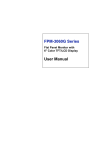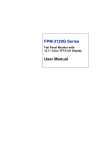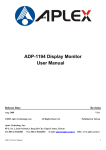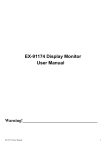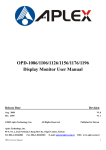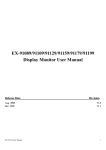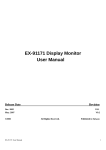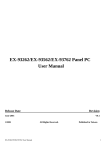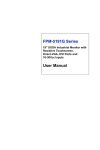Download Advantech FPM-3060G Series User manual
Transcript
FPM-3060G Flat Panel Monitor with 6" Color TFT/LCD Display User Manual Copyright Notice This document is copyrighted by Advantech Co., Ltd. All rights are reserved. Advantech Co., Ltd. reserves the right to make improvements to the products described in this manual at any time. Specifications are thus subject to change without notice. No part of this manual may be reproduced, copied, translated, or transmitted in any form or by any means without the prior written permission of Advantech Co., Ltd. Information provided in this manual is intended to be accurate and reliable. However, Advantech Co., Ltd., assumes no responsibility for its use, nor for any infringements upon the rights of third parties which may result from its use. All brand and product names mentioned herein are trademarks or registered trademarks of their respective holders. This Manual Covers the Following Models • FPM-3060G-XAE Ind. 6" VGA FPM w/ Direct-VGA Input • FPM-3060G-RAE FPM-3060G-XAE w/ Resistive TS (RS-232 interface) • FPM-3060G-UAE FPM-3060G-XAE w/ Resistive TS (USB interface) Part No. 2003306001 2nd Edition Printed in Taiwan January 2007 Product Warranty (1 year) FPM-3060G User Manual ii Advantech warrants to you, the original purchaser, that each of its products will be free from defects in materials and workmanship for one year from the date of purchase. This warranty does not apply to any products which have been repaired or altered by persons other than repair personnel authorized by Advantech, or which have been subject to misuse, abuse, accident or improper installation. Advantech assumes no liability under the terms of this warranty as a consequence of such events. All defective products under normal / standard operation will be serviced by Advantech’s global RMA system. If an Advantech product is defective, it will be repaired or replaced at no charge during the warranty period. For out-of-warranty repairs, you will be billed according to the cost of replacement materials, service time and freight. Please consult your dealer for more details. If you think you have a defective product, follow these steps: 1. Collect all the information about the problem encountered. (For example, CPU speed, Advantech products used, other hardware and software used, etc.) Note anything abnormal and list any onscreen messages you get when the problem occurs. 2. Call your dealer and describe the problem. Please have your manual, product, and any helpful information readily available. 3. If your product is diagnosed as defective, obtain an RMA (return merchandize authorization) number from your dealer. This allows us to process your return more quickly. 4. Carefully pack the defective product, a fully-completed Repair and Replacement Order Card and a photocopy proof of purchase date (such as your sales receipt) in a shippable container. A product returned without proof of the purchase date is not eligible for warranty service. 5. Write the RMA number visibly on the outside of the package and ship it prepaid to your dealer. iii FCC Class B This equipment has been tested and found to comply with the limits for a Class B digital device, pursuant to Part 15 of the FCC Rules. These limits are designed to provide reasonable protection against harmful interference when the equipment is operated in a residential environment. This equipment generates, uses and can radiate radio frequency energy. If not installed and used in accordance with this user's manual, it may cause harmful interference to radio communications. Note that even when this equipment is installed and used in accordance with this user’s manual, there is still no guarantee that interference will not occur. If this equipment is believed to be causeing harmful interference to radio or television reception, this can be determined by turning the equipment on and off. If the interference is occurring, the user is encouraged to try to correct the interference by one or more of the following measures: • Reorient or relocate the receiving antenna • Increase the separation between the equipment and the receiver • Connect the equipment to a power outlet on a circuit different from that to which the receiver is connected • Consult the dealer or an experienced radio/TV technician for help FPM-3060G User Manual iv Safety Instructions 1. Read these safety instructions carefully. 2. Keep this User's Manual for later reference. 3. Disconnect this equipment from any AC outlet before cleaning. Use a damp cloth. Do not use liquid or spray detergents for cleaning. 4. For plug-in equipment, the power outlet socket must be located near the equipment and must be easily accessible. 5. Keep this equipment away from humidity. 6. Put this equipment on a reliable surface during installation. Dropping it or letting it fall may cause damage. 7. The openings on the enclosure are for air convection. Protect the equipment from overheating. DO NOT COVER THE OPENINGS. 8. Make sure the voltage of the power source is correct before connecting the equipment to the power outlet. 9. Position the power cord so that people cannot step on it. Do not place anything over the power cord. 10. All cautions and warnings on the equipment should be noted. 11. If the equipment is not used for a long time, disconnect it from the power source to avoid damage by transient overvoltage. 12. Never pour any liquid into an opening. This may cause fire or electrical shock. 13. Never open the equipment. For safety reasons, the equipment should be opened only by qualified service personnel. 14. If one of the following situations arises, get the equipment checked by service personnel: a. The power cord or plug is damaged. b. Liquid has penetrated into the equipment. c. The equipment has been exposed to moisture. d. The equipment does not work well, or you cannot get it to work according to the user's manual. e. The equipment has been dropped and damaged. f. The equipment has obvious signs of breakage. v 15. DO NOT LEAVE THIS EQUIPMENT IN AN UNCONTROLLED ENVIRONMENT WHERE THE STORAGE TEMPERATURE IS BELOW -20° C (-4° F) OR ABOVE 60° C (140° F). THIS MAY DAMAGE THE EQUIPMENT. The sound pressure level at the operator's position according to IEC 7041:1982 is no more than 70dB(A). DISCLAIMER: This set of instructions is given according to IEC 704-1. Advantech disclaims all responsibility for the accuracy of any statements contained herein. FPM-3060G User Manual vi Contents Chapter 1 Introduction ..................................................... 2 1.1 1.2 1.3 1.4 1.5 1.6 Chapter Introduction ....................................................................... 2 Specifications .................................................................... 2 LCD Specifications ........................................................... 3 Power Adapter Specifications ........................................... 3 Connectors......................................................................... 4 Dimensions........................................................................ 5 Figure 1.1:FPM-3060G Chassis Dimensions ................ 5 2 System Setup.................................................... 8 2.1 Mounting FPM-3060G...................................................... 8 2.1.1 2.1.2 2.1.3 2.2 2.3 Wallmounting ................................................................ 8 Figure 2.1:Wallmounting ............................................... 8 Panel Mounting .............................................................. 9 Figure 2.2:Panel Mounting ............................................ 9 Swing-ARM (Standard VESA ARM) ........................... 9 Figure 2.3:Swing-ARM for the FPM-3060G series ...... 9 Power Adapter................................................................. 10 Mounted with MBPC-200 or UNO-2000 series ............ 10 2.3.1 2.3.2 Mounted with MBPC-200 Series ................................. 10 Mount with UNO-2000 Series ..................................... 10 Appendix A Display Timing Mode.................................... 12 A.1 Supported Input Timing Modes ...................................... 12 Table A.1:Supported Input Formats ............................ 12 Appendix B Touchscreen ................................................... 14 B.1 B.2 B.3 B.4 Introduction ..................................................................... 14 Touchscreen Specifications............................................. 14 Installing Driver for Windows 2000/XP ......................... 15 Configuring PenMount Windows 2000/XP Driver......... 20 B.5 Uninstall the PenMount Windows 2000/XP driver......... 32 B.4.1 B.4.2 B.4.3 PenMount Control Panel ............................................. 20 PenMount Monitor Menu Icon .................................... 30 PenMount Rotating Functions ..................................... 31 Appendix C OSD Operation Keypad................................ 34 C.1 Overview ......................................................................... 34 C.1.1 C.1.2 C.1.3 C.1.4 C.1.5 C.1.6 C.1.7 C.1.8 OSD Board Layout ...................................................... 34 OSD Button Description .............................................. 34 LED Functions ............................................................. 34 OSD Key Functions ..................................................... 35 Contrast/ Brightness Settings ....................................... 37 Geometry Menu – DVI Input ....................................... 38 Color Temperature Menu ............................................. 39 RGB Color Menu ......................................................... 40 vii C.1.9 C.1.10 C.1.11 C.1.12 C.1.13 C.1.14 FPM-3060G User Manual Language Menu ........................................................... 42 OSD Manager .............................................................. 43 Auto Configuration Menu ............................................ 44 Mode Information Menu .............................................. 45 Memory Recall Menu .................................................. 46 Exit Menu .................................................................... 47 viii CHAPTER 1 2 Introduction This chapter includes: • Introduction • Specifications • LCD Specification • Power Consumption • Connectors • Dimensions Chapter 1 Introduction 1.1 Introduction Advantech's FPM-3060G Series consists of 6" color TFT LCD flat panel monitors built specifically for industrial applications. With the optional touchscreen, the FPM-3060G Series is an user-friendly system control interface. In addition to its usual application as an LCD panel monitor, the FPM3060G Series comes standard with Direct VGA control signal input, making it compatible with industrial PCs and workstations. The OSD (On Screen Display) function allows you to adjust the display and turn the backlight on and off, a function that is highly appreciated among experienced users of industrial flat panel monitors. The whole chassis is made of stainless steel, and the front panel is of aluminum with NEMA4/IP65 compliance. Products in the FPM-3060G Series can also be provided in touchscreen versions. With a 4-wire resistive type touchscreen, this monitor can be immediately transformed into a remote control system. 1.2 Specifications General • Construction: Stainless steel chassis • Front Panel: Aluminum, NEMA4/IP65 compliant • Control: OSD (On Screen Display) control pad on front side • Mounting: Panel, MBPC-200 or optional kit for wall, UNO-2000 or VESA Arm • Dimensions (W x H x D): 220 x 150 x 45 mm (8.7” x 5.9” x 1.8”) • Panel Mount Cut out Dimension (W x H): 212.7x142.7 mm (8.37"x5.61") • Weight: 1.82 kg (4.01 lbs) • Vibration (operating): Random, 5 ~ 500 Hz, 1.0G Rms • Certifications: CE, FCC, BSMI, CCC • Power Consumption: 2.2A(max.) @12V +/- 10% FPM-3060G User Manual 2 Touchscreen (Optional) • Type: 4 wire, analog resistive • Light Transmission: >80% • Controller: RS-232 interface (for FPM-3060G-RXX version) or USB 1.1 (for FPM-3060G-UXX version) • Power Consumption: FPM-3060G-RXX:+5 V @ 200 mA FPM-3060G-UXX:+5 V @ 100 mA (USB bus power) • OS Support: (RS-232) DOS, Windows 95/98/ME/2000/XP (USB) Windows 95/98/ME/2000/XP/CE • Life Span: 10 million with a silicone rubber of R8 finger, writing rate is by 250g at 2 times/s 1.3 LCD Specifications • Display Type: VGA TFT- LCD • Display Size: 6.5" • Max. Colors: 262 k • Max. Resolution: 640 x 480 • Viewing Angle (H/V): 140°, 120° • Luminance: 300 cd/m2 • Storage Temperature:-20 ~ 60° C (-4 ~ 140° F) • Operating Temperature: 0 ~ 50° C (32 ~ 122° F) • Contrast Ratio: 500 : 1 (typical) • Lamp Life Time: 50,000 hrs 1.4 Power Adapter Specifications • Max Output Power: 42 Watts • AC input voltage: 100 - 240 V AC • Output voltage: + 12 V @ 3.5 A • Safety Standards: UL/CE/CCC/TUV/CB 3 Chapter 1 1.5 Connectors The following connectors are on the bottom of the FPM-3060G Series: VGA Port (DB15) This DB-15 connector can be connected to the system via the external 15pin video signal cable. RS-232 Touchscreen Connector (DB9) (FPM-3060G-RXX) This connector will only be present if a touchscreen is installed. It must be connected to the RS-232 port of the PC. The touchscreen cable is included with all orders that include the touchscreen option. USB Touchscreen Connector (USB type B) (FPM-3060G-UXX) This connector will only be present if a touchscreen is installed. It must be connected to the USB port of the PC. The touchscreen cable is included with all orders that include the touchscreen option. DC 12V Power In This connector connects to the DC 12V Switching Power Supply. Warning: Before you connect a VGA cable between FPM-3060G and a PC, please note the following issues. 1. If you have installed a operating system in the PC, make sure the vertical frequency is within the acceptable range. (Refer to Appendix B) 2. If you have not installed a operating system, you have to adjust the vertical frequency to fall within the range. FPM-3060G User Manual 4 1.6 Dimensions Figure 1.1: FPM-3060G Chassis Dimensions 5 Chapter 1 FPM-3060G User Manual 6 CHAPTER 2 2 System Setup • Mounting the Monitor • Wall / Panel / VESA Arm Mounting • Mounting with MBPC-200 or UNO-2000 Series Chapter 2 System Setup 2.1 Mounting FPM-3060G The FPM-3060G Series can be flexibly mounted. The versatility of the FPM-3060G enable it to be mounted almost anywhere. 2.1.1 Wallmounting Please refer to figure 2.1 and follow the steps below to install FPM3060G on a wall. The wallmounting kit is optional. (P/N: FPM-3060VESA-MTE) 1. Screw the mounting kit with FPM-3060G. 2. Screw three screws on the wall with the dimensions used in Figure 2.1. 3. Hook FPM-3060G on the screws Figure 2.1: Wallmounting FPM-3060G User Manual 8 2.1.2 Panel Mounting Refer to figure 2.2 and follow the instructions below to install in a panel. 1. Place six panel-mounting brackets on FPM-3060G (2 on the top, 2 on the left, and 2 on the right). 2. Fasten the six panel-mounting brackets with screws. 3. Mount FPM-3060G by the 6 screws on the six panel-mounted brackets. Please note that the panel thickness must be below 6 mm. Figure 2.2: Panel Mounting 2.1.3 Swing-ARM (Standard VESA ARM) FPM-3060G has been designed with support for the VESA arm standard. Refer to figure 2.5. Attach the mounting brackets on the rear side, then attach the FPM-3060G onto the VESA ARM mount. The dimensions of the mount hole is M5, and the mounting bracket is optional. (P/N: FPM-3060VESA-MTE) Figure 2.3: Swing-ARM for the FPM-3060G series 9 Chapter 2 2.2 Power Adapter The power adapter bracket is attached to the rear of FPM-3060G. Attach/ detach the power bracket at the rear side of the monitor by screwing/ unscrewing the four screws. 2.3 Mounted with MBPC-200 or UNO-2000 series FPM-3060G can easily be combined with products in the MBPC-200 or UNO-2000 series. 2.3.1 Mounted with MBPC-200 Series FPM-3060G can be directly mounted with MBPC-200 series products with four M3 screws (not included). 2.3.2 Mount with UNO-2000 Series FPM-3060G can be easily mounted with UNO-2000 products by the optional kit FPM-3060VESA-MT. FPM-3060G User Manual 10 A APPENDIX 2 Display Timing Mode Appendix A Display Timing Mode A.1 Supported Input Timing Modes The different frequencies below are already programmed in this module, and the synchronous signal inputs are automatically recognized. Table A.1: Supported Input Formats Vertical Frequencies Resolution 640 x 480 60 Hz 70 Hz 72 Hz 75 Hz Yes 640 x 400 Yes 640 x 350 Yes 720 x 400 Yes Note 1: Even if the preset timing is entered, some adjustment of functions such as Horizontal period, CLK-delay and display position, are required. The adjusted values are memorized in every preset number. Note 2: This module recognizes the synchronous signals with near preset timing of the frequency of the HS and Vsync, even in the case that the signals other than the preset timing that were entered. Note 3: Because adjustments may not fit, such as differing magnifying ratios or, in the case that you use it except for the display timing that was preset. FPM-3060G User Manual 12 APPENDIX B 2 Touchscreen This appendix contains information on the touchscreen, and its installation. Appendix B Touchscreen B.1 Introduction The FPM-3060 Series’ optional touchscreen uses advanced 3M™ 8-wire resistive technology. It provides more accurate sensing capacity than other technologies. The touchscreen is specially designed for tough industrial environments, and has been approved to FCC Class B standards. B.2 Touchscreen Specifications Electrical • Contact bounce: < 10 ms • Operating voltage: 5 V (typical) • Sheet Resistance: 350 +/- 22% W per Square. • Linearity: <1.5% full scale linearity error in either direction. • Insulation Resistance: >20 MW @ 25 V DC Durability • Test conditions: 4 H hardness, 0.04" stylus pen, 350 gram load • Point activation: 1 Million activations on a single point with a 5/8" diameter silicone finger with a 350g load at 2 Hz • Character Activation Life: >100,000 characters written within a 20 mm x 20 mm area on the touch screen. • Chemical resistance: Hard coating is highly resistant to most solvents and chemicals FPM-3060G User Manual 14 Optical • Visible light transmission: 75% typical (>74% @ 550 nm test) • Clarity: Clear Finish - 25%, Antiglare Finish - 15% Sensor board • Chemical strengthened glass with 4 H hardness standard. (Test condition: ASTM D3363-92A) Ball drop test • Able to bear a 225 g steel ball dropped from 660 mm elevation without breaking Environmental Specifications • Operating Temperature Range: -20° C ~ +50° C, 2 weeks at 50° C / 90% RH. • Storage Temperature High: +70° C, 240 hours at ambient humidity. • Storage Temperature Low: -40° C, continuous at ambient humidity. • Accelerated Aging: 100 hours at 60° C / 95% RH. • Thermal Shock: 25 cycles (one cycle is 30 min. dwell alternating from -40 to +85° C with less than 10 min. transfer time. B.3 Installing Driver for Windows 2000/XP The touchscreen has drivers for Windows 2000 and Windows XP. You should read the instructions in this chapter carefully before you attempt installation. Note 1: The following windows illustrations are examples only. You must follow the flow chart instructions and pay attention to the instructions which then appear on your screen. Note 2: Install the HMI CD Driver into the system CD-ROM (D:\ means CD-ROM) 15 Appendix B Before installing the Windows 2000/XP driver software, you must have the Windows 2000/XP system installed and running on your computer. If you have an older version of the PenMount Windows 2000/XP driver installed in your system, please remove it first. Follow the steps below to install the PenMount Windows 2000/XP driver. 1. When the system first detects the controller board, a screen appears that shows “Unknown Device.” Do not use this hardware wizard. Press Cancel. 2. FPM-3060G-RXE Insert the Driver CD-ROM. Go to: \TouchScreen-DRV\PenMount Driver\DMC 9000 (RS-232) FPM-3060G-UXE Insert the Driver CD-ROM. Go to: \TouchScreen-DRV\PenMount Driver\DMC 5000 (USB) FPM-3060G User Manual 16 3. The screen displays the installation wizard for the PenMount software. Click “Next”. 17 Appendix B 4. A License Agreement appears. Click “I accept…” and “Next” 5. The “Ready to Install the Program” screen appears. Select “Install.” FPM-3060G User Manual 18 6. The next screen is “Hardware Installation.” Select “Continue Anyway.” 7. The “InstallShield Wizard Completed” appears. Click “Finish.” 19 Appendix B B.4 Configuring PenMount Windows 2000/XP Driver Upon rebooting, the computer automatically finds the new 9000 controller board. The touchscreen is connected but not calibrated. Follow the procedures below to carry out calibration. 1. After installation, click the PenMount Monitor icon “PM” in the menu bar. 2. When the PenMount Control Panel appears, click “Calibrate.” B.4.1 PenMount Control Panel The functions of the PenMount Control Panel are Calibrate, Draw, Multiple Monitors, Option, and About, which are explained in the following sections. Calibrate This function offers two ways to calibrate your touchscreen. ‘Standard Calibration’ adjusts most touchscreens. ‘Advanced Calibration’ adjusts aging touchscreens. Standard Calibration Click this button and arrows appear pointing to red squares. Use your finger or stylus to touch the red squares in sequence. After the fifth red point calibration is complete. To skip, press ‘ESC’. Advanced Calibration Advanced Calibration uses 4, 9, 16 or 25 points to effectively calibrate touch panel linearity of aged touch screens. Click this button and touch the red squares in sequence with a stylus. To skip, press ‘ESC’. FPM-3060G User Manual 20 Note: The older the touchscreen, the more Advanced Mode calibration points you need for an accurate calibration. Use a stylus during Advanced Calibration for greater accuracy. 21 Appendix B FPM-3060G User Manual 22 Plot Calibration Data Check this function and a touch panel linearity comparison graph appears when you have finished Advanced Calibration. The blue lines show linearity before calibration and black lines show linearity after calibration. 23 Appendix B Draw Tests or demonstrates the PenMount touchscreen operation. The display shows touch location. Click Draw to start. Touch the screen with your finger or a stylus and the drawing screen registers touch activity such left, right, up, down, pen up, and pen down. Touch the screen with your finger or a stylus and the drawing screen registers touch activity such left, right, up, down, pen up, and pen down. Click Clear Screen to clear the drawing. FPM-3060G User Manual 24 Multiple Monitors Multiple Monitors supports from two to six touch screen displays for one system. The PenMount drivers for Windows 2000/XP support Multiple Monitors. This function supports from two to six touch screen displays for one system. Each monitor requires its own PenMount touch screen control board, either installed inside the display or in a central unit. The PenMount control boards must be connected to the computer COM ports via the RS-232 interface. Driver installation procedures are the same as for a single monitor. Multiple Monitors supports the following modes: Windows Extend Monitor Function Matrox DualHead Multi-Screen Function nVidia nView Function NOTE: The Multiple Monitors function is for use with multiple displays only. Do not use this function if you have only one touch screen display. Please note once you turn on this function the Rotating function is disabled. Enable the multiple display function as follows: 1. Check the Enable Multiple Monitor Support box; then click Map Touch Screens to assign touch controllers to displays. 25 Appendix B 2. When the mapping screen message appears, click OK. 3. Touch each screen as it displays “Please touch this monitor.” Following this sequence and touching each screen is called mapping the touch screens. FPM-3060G User Manual 26 4. Touching all screens completes the mapping and the desktop reappears on the monitors. 5. Select a display and execute the ‘Calibration’ function. A message to start calibration appears. Click OK. 6. “Touch this screen to start its calibration” appears on one of the screens. Touch the screen. 7. “Touch the red square” messages appear. Touch the red squares in sequence. 8. Continue calibration for each monitor by clicking Standard Calibration and touching the red squares. 27 Appendix B NOTE: 1. If you used a single VGA output for multiple monitors, please do not use the Multiple Monitors function. Just follow the regular procedure for calibration on each of your desktop monitors. 2. The Rotating function is disabled if you use the Multiple Monitors function. 3. If you change the resolution of display or screen address, you have to redo Map Touch Screens so the system understands where the displays are. Option This panel function supports two modes—Operation Mode and Beep Sound Mode—which allow configuration for specific touch screen applications, such as point-of-sales (POS) terminals. Operation Mode This mode enables and disables the mouse’s ability to drag on-screen icons useful for configuring POS terminals. Stream Mode – Select this mode and the mouse functions as normal and allows dragging of icons. Point Mode – Select this mode and the mouse only provides a click function, and dragging is disabled. Beep Sound Mode Enable Beep Sound – turns beep function on and off Beep on Pen Down – beep occurs when pen comes down Beep on Pen Up – beep occurs when pen is lifted up Beep on both of Pen Down/Up – beep occurs on both Beep Frequency – modifies sound frequency Beep Duration – modifies sound duration FPM-3060G User Manual 28 About This panel displays information about the PenMount controller and driver version. 29 Appendix B B.4.2 PenMount Monitor Menu Icon PenMount monitor icon (PM) appears in the menu bar of Windows 2000/ XP system when you turn on PenMount Monitor in PenMount Utilities. PenMount Monitor has the following functions. Beep Turns beep on or off. Right Button When you select this function, a mouse icon appears in the right-bottom of the screen. Click this icon to switch between Right and Left Button functions. Pen Stabilizer Check this function to reduce cursor vibration for relatively unstable touch screens, or where there may be excess vibration. Normally this function is not checked. Exit Exits the PenMount Monitor function. FPM-3060G User Manual 30 B.4.3 PenMount Rotating Functions The PenMount driver for Windows 2000/XP supports several display rotating software packages. Please see Chapter 5 for more information. The PenMount drivers for Windows 95, Windows 98/Me, Windows 2000/XP, as well as Windows 98 USB and Windows Me/2000/XP support display rotating software packages such as: • Portrait’s Pivot Screen Rotation Software • ATI Display Driver Rotate Function • nVidia Display Driver Rotate Function • SMI Display Driver Rotate Function • Intel 845G/GE Display Driver Rotate Function Configuring the Rotate Function 1. Install the rotation software package. 2. Choose the rotate function (0°, 90°, 180°, 270°) in the 3rd party software. The calibration screen appears automatically. Touch this point and rotation is mapped. NOTE: The Rotate function is disabled if you use Monitor Mapping 31 Appendix B B.5 Uninstall the PenMount Windows 2000/XP driver 1. Exit the PenMount monitor (PM) in the menu bar. 2. Go to Settings, then Control Panel, and then click Add/Remove program. Select PenMount DMC9000 and click the Add/Remove button. 3. Select PenMount DMC9000 and DMC9100. Click the Remove button. 4. Select ‘Yes’ and “Close” to remove the PenMount Windows 2000/ XP driver, and reboot the system. FPM-3060G User Manual 32 C APPENDIX 2 OSD Operation Keypad Appendix C OSD Operation Keypad C.1 Overview C.1.1 OSD Board Layout The OSD keypad, including six keys and a two color indicator, is designed as the OSD operation interface. C.1.2 OSD Button Description Buttons Descriptions Power Exit Down / Right / Increase Up/Left/ Decrease Turn the monitor power ON or OFF. Exit menu. Activate the volume control. Move the selector to the next option. Increase the gauge value of the selected option. Active volume control. Move the selector to the previous option. Decrease the gauge value of the selected option. Activate the OSD menu. Enter/confirm the selected option. Automatically adjust the clock, phase, H-position and V-position. Menu/Sel Auto C.1.3 LED Functions ON StandBy/OFF No Signals FPM-3060G User Manual Green Green Blinking Orange 34 C.1.4 OSD Key Functions Each selected value is stored into LCD memory after SEL signal input or time out. The stored values are not affected if the power is turned off. But the selected value is not available in case a selected mode is changed before time out or power is turned off before time out. TIME OUT Æ 5-6 seconds ( Can be set in OSD Manager) The default definition of input keys is shown as following: 1. • MENU START Generate Main Menu Press MENU Button in OSD function key • Main Menu -- DISPLAY IN SCREEN • Sub-Menu – DISPLAY IN SCREEN N/A • Available Key Functions N/A N/A Select to exit menu or wait for time out N/A N/A N/A 35 Appendix C 2. INPUT SOURCE SELECT • Generate Main Menu Select by Left and Right Button, press Menu Button for selection confirmation • Main Menu -- DISPLAY IN SCREEN • Sub-Menu – DISPLAY IN SCREEN • Available Key Functions Power Off the LCD Monitor Increase the gauge value of the selected option. Return to last menu Selected to confirm Decrease the gauge value of the selected option. N/A FPM-3060G User Manual 36 • Auto Select Input • ON ‡ start from default setting and scan the inputs by following sequence from ANALOG INPUT, DIGITAL INPUT, S-VIDEO INPUT, and CVBS INPUT. • OFF ‡ start from default setting C.1.5 Contrast/ Brightness Settings • Generate Main Menu Select by Left and Right Button, press Menu Button for selection confirmation • Main Menu -- DISPLAY IN SCREEN • Sub-Menu – DISPLAY IN SCREEN 37 Appendix C • Available Key Functions Power Off the LCD Monitor Increase the gauge value of the selected option. Return to last menu Selected to confirm Decrease the gauge value of the selected option. N/A Recall Value – User Defined • Rec1: Pressed to record 1st setting as recall value followed by current screen setting • Rec2: Pressed to record 2nd setting as recall value followed by current screen setting • Recall: Switch the setting change by Rec1 and Rec2 while pressed C.1.6 Geometry Menu – DVI Input Generate Main Menu Select by Left and Right Button, press Menu Button for selection confirmation • Main Menu -- DISPLAY IN SCREEN FPM-3060G User Manual 38 • Sub-Menu – DISPLAY IN SCREEN • Available Key Functions Power Off the LCD Monitor Increase the gauge value of the selected option. Return to last menu Selected to confirm Decrease the gauge value of the selected option. N/A C.1.7 Color Temperature Menu Generate Main Menu Select by Left and Right Button, press Menu Button for selection confirmation • Main Menu -- DISPLAY IN SCREEN 39 Appendix C • Sub-Menu – DISPLAY IN SCREEN • Available Key Functions Power Off the LCD Monitor Increase the gauge value of the selected option. Return to last menu Selected to confirm Decrease the gauge value of the selected option. N/A C.1.8 RGB Color Menu Generate Main Menu Select by Left and Right Button, press Menu Button for selection confirmation Select by Left and Right Button, Press Menu Button for selection confirmation FPM-3060G User Manual 40 • Main Menu -- DISPLAY IN SCREEN • Sub-Menu – DISPLAY IN SCREEN • Sub-Menu – DISPLAY IN SCREEN • Available Key Functions Power Off the LCD Monitor Increase the gauge value of the selected option. Return to last menu Selected to confirm Decrease the gauge value of the selected option. N/A Customization setting for RGB colors 41 Appendix C C.1.9 Language Menu Generate Main Menu Select by Left and Right Button, press Menu Button for selection confirmation • Main Menu -- DISPLAY IN SCREEN • Sub-Menu – DISPLAY IN SCREEN • Available Key Functions Power Off the LCD Monitor Increase the gauge value of the selected option. Return to last menu Selected to confirm Decrease the gauge value of the selected option. N/A FPM-3060G User Manual 42 C.1.10 OSD Manager Generate Main Menu Select by Left and Right Button, press Menu Button for selection confirmation • Main Menu -- DISPLAY IN SCREEN • Sub-Menu – DISPLAY IN SCREEN • Available Key Functions Power Off the LCD Monitor Increase the gauge value of the selected option. Return to last menu Selected to confirm Decrease the gauge value of the selected option. N/A 43 Appendix C C.1.11 Auto Configuration Menu Generate Main Menu Select by Left and Right Button, press Menu Button for selection confirmation • Main Menu -- DISPLAY IN SCREEN • Sub-Menu – DISPLAY IN SCREEN • Available Key Functions Power Off the LCD Monitor Increase the gauge value of the selected option. Return to last menu Selected to confirm Decrease the gauge value of the selected option. N/A FPM-3060G User Manual 44 Auto configuration can be set in menu and also can press the without any menu indication. C.1.12 Mode Information Menu Generate Main Menu Select by Left and Right Button, press Menu Button for selection confirmation • Main Menu -- DISPLAY IN SCREEN • Sub-Menu – DISPLAY IN SCREEN • Available Key Functions Power Off the LCD Monitor Increase the gauge value of the selected option. Return to last menu Selected to confirm Decrease the gauge value of the selected option. N/A 45 Appendix C C.1.13 Memory Recall Menu Generate Main Menu Select by Left and Right Button, press Menu Button for selection confirmation • Main Menu -- DISPLAY IN SCREEN • Sub-Menu – DISPLAY IN SCREEN • Available Key Functions Power Off the LCD Monitor Increase the gauge value of the selected option. Return to last menu Selected to confirm Decrease the gauge value of the selected option. N/A FPM-3060G User Manual 46 C.1.14 Exit Menu Generate Main Menu Select by Left and Right Button, press Menu Button for selection confirmation • Main Menu -- DISPLAY IN SCREEN • Sub-Menu – DISPLAY IN SCREEN • Available Key Functions Power Off the LCD Monitor Increase the gauge value of the selected option. Return to last menu Selected to confirm Decrease the gauge value of the selected option. N/A 47 Appendix C HOT KEYS OSD LOCK/UNLOCK HOT KEYS Press first then press for change this setting, Followed this sequence for the button press so that you can have OSD LOCK and UNLOCK setting Entry OSD LOCK MODE Press HOT KEY, the screen will show this action first Don’t remove the HOT KEY until this task is finished. Entry OSD UNLOCK MODE Press HOT KEY, the screen will show this action first Don’t remove the HOT KEY until the screen indicated this task is finished. FPM-3060G User Manual 48
























































